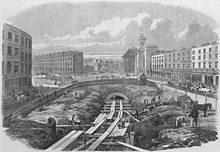Úsáideoir:Runab WMF/ga test page


Rapid transit, also known as metro, subway, underground, or colloquially as "the train", is a type of high-capacity public transport generally found in urban areas.[1][2][3] Unlike buses, trams or light rail, rapid transit systems are electric railways that operate on an exclusive right-of-way, which cannot be accessed by pedestrians or other vehicles of any sort,[4] and which is often grade separated in tunnels or on elevated railways.
Modern services on rapid transit systems are provided on designated lines between stations typically using electric multiple units on rail tracks, although some systems use guided rubber tyres, magnetic levitation, or monorail. The stations typically have high platforms, without steps inside the trains, requiring custom-made trains in order to avoid gaps. They are typically integrated with other public transport and often operated by the same public transport authorities. However, some rapid transit systems have at-grade intersections between a rapid transit line and a road or between two rapid transit lines.[5] It is unchallenged in its ability to transport large numbers of people quickly over short distances with little use of land. Variations of rapid transit include people movers, small-scale light metro, and the commuter rail hybrid S-Bahn.
The world's first rapid-transit system was the partially underground Metropolitan Railway which opened as a conventional railway in 1863, and now forms part of the London Underground.[6] In 1868, New York opened the elevated West Side and Yonkers Patent Railway, initially a cable-hauled line using static steam engines.
The world's largest rapid transit system by both length of track (842 miles (1,355 km), including non-revenue track)[7] and number of stations (468 stations in total)[8] is the New York City Subway. By length of passenger route, the world's longest single-operator rapid transit system is the Shanghai Metro.[9][10] The busiest rapid transit systems in the world by annual ridership are the Tokyo subway system, the Seoul Metropolitan Subway, the Moscow Metro, the Beijing Metro, and the Shanghai Metro.[11]
Terminology
[cuir in eagar | athraigh foinse]Metro is the most common term for underground rapid transit systems used by non-native English speakers.[12] Rapid transit systems may be named after the medium by which passengers travel in busy central business districts; the use of tunnels inspires names such as subway,[13] underground,[14] Untergrundbahn (U-Bahn) in German,[15] or the Tunnelbana (T-bana) in Swedish;[16] the use of viaducts inspires names such as elevated (el or L), skytrain,[17] overhead, or overground. One of these terms may apply to an entire system, even if a large part of the network (for example, in outer suburbs) runs at ground level.
History
[cuir in eagar | athraigh foinse]
Advancements in technology have allowed new automated services. Hybrid solutions have also evolved, such as tram-train and premetro, which incorporate some of the features of rapid transit systems.[18] In response to cost, engineering considerations and topological challenges some cities have opted to construct tram systems.[19]
Operation
[cuir in eagar | athraigh foinse]Rapid transit is used in cities, agglomerations, and metropolitan areas to transport large numbers of people often short distances at high frequency. The extent of the rapid transit system varies greatly between cities, with several transport strategies.
Some systems may extend only to the limits of the inner city, or to its inner ring of suburbs with trains making frequent station stops. The outer suburbs may then be reached by a separate commuter rail network where more widely spaced stations allow higher speeds. In some cases the differences between urban rapid transit and suburban systems are not clear.[3]
Rapid transit systems may be supplemented by other systems such as buses, trams, or commuter rail. This combination of transit modes serves to offset certain limitations of rapid transit such as limited stops and long walking distances between outside access points. Bus or tram feeder systems transport people to rapid transit stops.[20] In Toronto, over 50% of its rapid transit stations have bus and streetcar terminals within the fare-paid zone, providing a connection without requiring proof of payment.[citation needed]
- ↑ Tá ort na shonrú' 'teideal = agus' 'url = nuair a úsáideann {{ lua idirlín}}."".
- ↑ Tá ort na shonrú' 'teideal = agus' 'url = nuair a úsáideann {{ lua idirlín}}."" (2011).
- ↑ 3.0 3.1 Tá ort na shonrú' 'teideal = agus' 'url = nuair a úsáideann {{ lua idirlín}}."".
- ↑ Tá ort na shonrú' 'teideal = agus' 'url = nuair a úsáideann {{ lua idirlín}}."".
- ↑ Tá ort na shonrú' 'teideal = agus' 'url = nuair a úsáideann {{ lua idirlín}}."".
- ↑ Transport for London. "London Underground: History". Dáta rochtana: 2013-01-02.
- ↑ Tá ort na shonrú' 'teideal = agus' 'url = nuair a úsáideann {{ lua idirlín}}."".
- ↑ Tá ort na shonrú' 'teideal = agus' 'url = nuair a úsáideann {{ lua idirlín}}."".
- ↑ "Shanghai now the world's longest metro" (4 May 2010). Railway Gazette International. Dáta rochtana: 2010-05-04.
- ↑ Tá ort na shonrú' 'teideal = agus' 'url = nuair a úsáideann {{ lua idirlín}}."".
- ↑ Tá ort na shonrú' 'teideal = agus' 'url = nuair a úsáideann {{ lua idirlín}}."" (2014).
- ↑ Fjellstrom&Wright, 2002: p.2
- ↑ Executive ed.: Joseph P. Pickert... (2000). "The American Heritage Dictionary of the English Language, Fourth Edition". Houghton Mifflin Company.
- ↑ Tá ort na shonrú' 'teideal = agus' 'url = nuair a úsáideann {{ lua idirlín}}."".
- ↑ White, 2002: 63
- ↑ Ovenden, 2007: 93
- ↑ Ovenden, 2007: 16
- ↑ Ovenden, 2007: 7
- ↑ Tá ort na shonrú' 'teideal = agus' 'url = nuair a úsáideann {{ lua idirlín}}."".
- ↑ Cervero, 1998: 13
